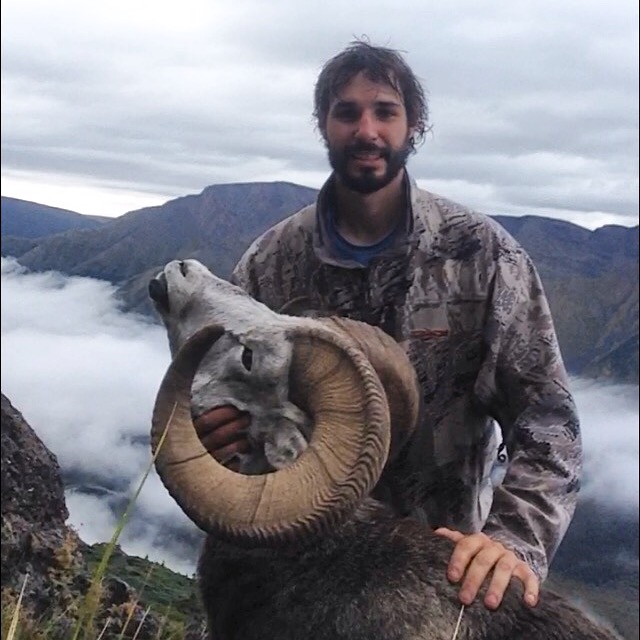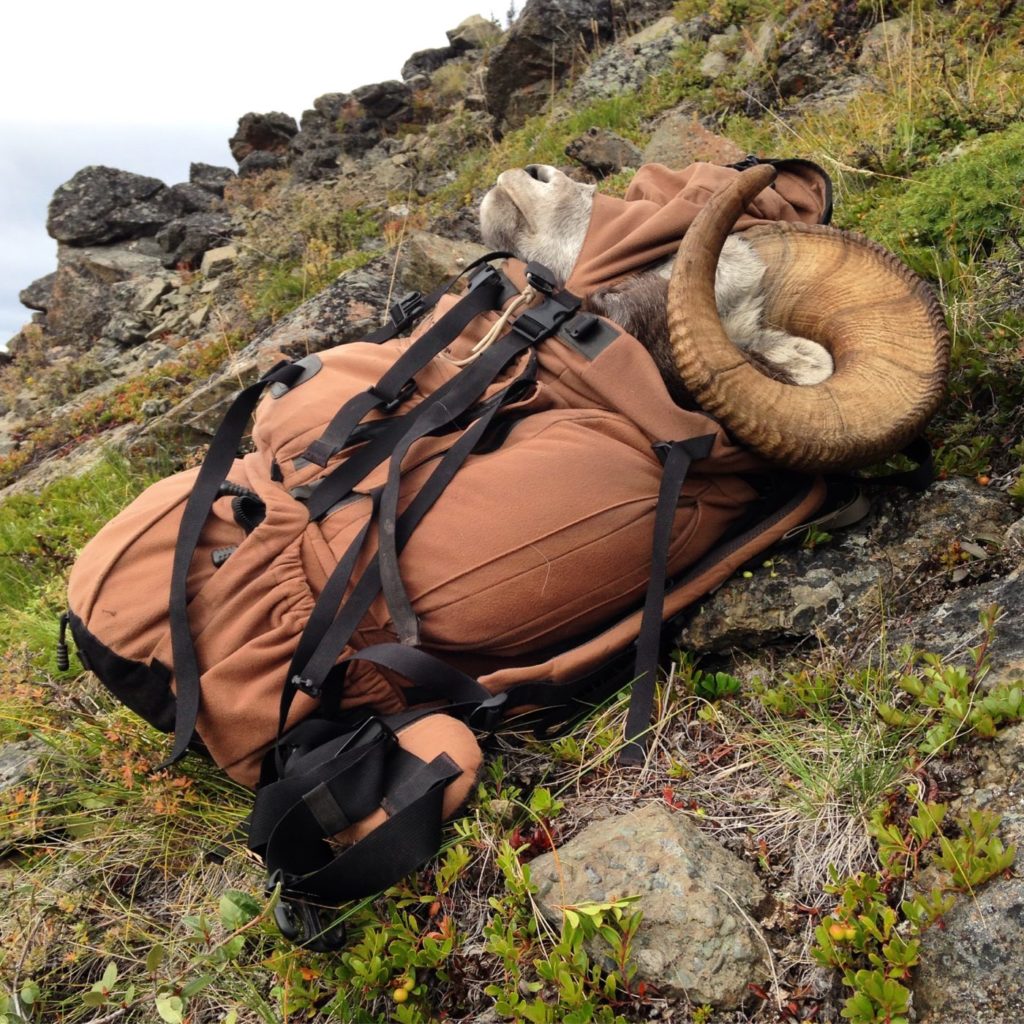It was a late June night, and I was twisting and turning in bed; trying to get comfortable enough to fall asleep seemed to be something that wasn’t about to happen. At least I didn’t have to go to work in the morning, I thought to myself. I decided to make my way to the living room to watch a movie, hoping that would make me drowsy enough to crawl back into bed fairly soon.
As I was lying on the couch, scrolling through the movie channels and not finding anything worth watching, I reached the point of giving up. My eyes started to wander to my right, towards the “Sheep Wall.”
A couple Stone sheep shoulder mounts are displayed side by side, with a third ram—a European mount—sitting on the couch’s end table. I proceeded to get up to hold the ram horns like I have done so many times before. It doesn’t get old.
I got to reminiscing; I just couldn’t help it. As previous hunts played through my mind like films, I began thinking about how my ten-year sheep hunting career had gone. Looking back, my first seasons chasing rams were, without a doubt, the most challenging. Everything was new to me, and I had to learn as I went and grow as a mountain bowhunter.
In this two-part article, I will go over some of the mistakes I made, and lessons I learned—often the hard way—over the past decade of mountain hunting. In no way am I implying that I don’t make mistakes anymore or that I know all there is to know about the backcountry or the challenges we as hunters may face, but hopefully you can pick up a couple things that may just stack the odds a little more in your favour. Or at least make your hunts more comfortable and productive.
I’m going to start with the basics: choosing the right gear, and how to pack it. The amount and quality of mountain hunting gear that’s available to us has just exploded over the past few years. There are numerous excellent gear manufacturers in the hunting and climbing/alpine world that can get you set up with the right clothing systems and equipment to be ready to hit sheep country at any point in the season. That said, high quality gear is expensive and you may not be able to purchase everything you have your heart set on. I couldn’t afford everything I was “supposed” to buy for years but still got out there. Don’t let a less than perfect gear closet push you away from getting into the mountains.
If you’re on a budget, I strongly recommend spending the bulk of your money on three basic, but critical items: boots, rain gear, and optics. Having the right boots for your feet will increase not only the fun factor, but your feet get you where you’ll need to be to have an opportunity to shoot a ram or big billy! Treat them well. It’s hard to stay motivated after a few days of hiking in the mountains with feet covered in blisters and/or hot spots.
I learned this lesson the hard way on my first sheep hunt, and it’s a lesson I won’t ever forget. I was using second hand boots a half-size too large, causing my toes to slide forward on the descents to the point where I had blisters on top of my toes from constantly rubbing the top of the toe box. After about day five, every single step hurt and I was miserable. Lesson learned! Try on as many brands of boots as you can to see what fit your feet the best; whatever boot you decide on, break it in hiking or scouting during the summer before your sheep hunt—you’ll be glad you did. For more in-depth material on boots and boot fitting, check out the Roam column here in the JOMH or just pluP “feet” into the search bar of the JOMH homepage. There is some great content there.
Hunting in the mountains means we’re going to encounter a variety of different weather conditions, regardless of what part of the season you hunt. Having high quality rain gear is another must for me. Most of us only get to hunt a few weeks out of the year if we’re lucky and I don’t want the weather to impact my hunt any more than necessary. Good rain gear is often the difference between still being able to hunt and having to spend valuable hunting time drying out and warming up.
Allow me to go back to another one of my early experiences hunting Stones in mid-August. After a few days of beautiful, sunny weather, my dad and I were in for a surprise when the weather took a 180-degree turn for the worse and we got hammered by rain for hours at a time every day. Once again reaching into my “that’ll do” collection of gear, my subpar rain gear left me hanging, and soaked in the mountains for days. This led to me getting sick and unable to hunt as hard as I wanted; it was not fun. Lesson learned! Spend the cash on good rain gear, because you never know what kind of weather you’ll face and at some point, you will get hit by nasty weather. It’s just a matter of time.
Optics are another must. Having good glass can make the difference in spotting that giant ram you’ve only dreamed of seeing. Buy the absolute best glass you can afford, and if need be, borrow a spotter from a friend and save your money for another year rather than rushing to buy subpar glass. Taking the time to glass and pick the mountain apart is more valuable than anything. Save your energy and put your eyes to work, not just your feet. This is a lesson every seasoned sheep hunter repeats like a broken record. You’ll be surprised what seems to appear out of nowhere!
For first-time mountain hunters looking for a full gear list, a great article to check out is Adam Foss’ “What’s in the Pack,” from the May 2016 issue of the JOMH. Adam is a very experienced mountain hunter that understands what is needed, and it’s a great guideline to give you an understanding of what to consider taking—and not taking—with you on an extended backcountry outing.
Now that we’ve covered the must-haves and basics that make up a gear list, I’m going to explain how I pack it. Most mountain hunters with experience will know this already, but it’s an important thing that—to my surprise—still gets overlooked.
I start by putting in my sleeping bag and tent first—the lighter, bulkier things that I most likely won’t need until I get to my next planned stop on the mountain. I follow that with the bulk of my food. Stacked on top of that will be a synthetic puffy, beanie, gloves, and additional insulation if I’m hunting the late season. The remaining 10% of food is stuffed in a freezer bag and kept right up top of the pack along with a lighter, stove, knife, and other small accessories that should remain dry. The rain gear gets stored last since I may be forced to wear it at any given point. You don’t want to waste time digging through your entire pack looking for a snack or rain gear when a storm rolls in.
If you happen to be successful, I recommend packing your backpack in much the same way. The meat gets de-boned and stacked in the top of my pack, with the rain gear in an accessible spot, and the skull and horns tied off right under the pack’s lid. I learned this lesson in 2015, when I went out on my first true solo mountain hunt. I was successful at arrowing a great ram on a cool October day. I had my near-empty pack with me, and after getting the back straps, tenderloins, and other edible portions of meat off the ram, I made the decision to only quarter the ram in order to save time to get back to my tent before it got completely dark. Little did I know it would get well below freezing overnight, and I was forced to carry out a lot of leg bone the following day—the meat was frozen rock-solid and I was unable to de-bone anything. I didn’t have a choice but to carry out extra weight and tie off items to the outside of my pack because there wasn’t enough room inside of it. It made for an extra-heavy, painful load and experience I don’t want to relive again if I have a choice. Packing everything in a proper manner and de-boning the meat right away, under headlamp if need be, will make your trip out much easier.
Bringing along the proper food to keep your body and mind going is similarly very important. The meals I choose to carry with me are pretty basic, but standard for backpack hunting. My focus is to pack food that’s light weight but at the same time provides the right kind of energy and calories. There is of course lots of debate about what to eat and the key with food is to find out what works for you. This means testing different foods and snacks out in the pre-season, when scouting and training, to see whether you need more, less or something entirely different. I’m a big believer in keeping things simple and my daily meal plan reflects that. But you need to figure out what works for you and your body.
I prefer packing each day’s food in its own separate freezer bag. That way I know exactly what I’m able to eat each day and have all my rations organized. A full day’s supply of food for me personally consists of a pouch of oatmeal that I can just add water to in the morning for a quick and easy breakfast. For a snack and lunch I’ll have a Snickers and a Mr. Noodles. They both provide a good amount of calories at a light weight. Afternoon snack is a couple handfuls of trail mix; I prefer something with dried fruits and peanuts. To finish off my daily meals is a freeze-dried dinner like Mountain House. Although I go as light as possible with all my food and gear, the past few years I sacrifice a little weight by bringing along a small salami and some cheese. Even just one solid bite of each every couple days makes me feel better. Not something I need but something I prefer to bring along.
Staying hydrated is also vital. In August it seems easier to drink, but I’ve found that hunting later in the year, I don’t typically drink as much because it’s not as warm out and I don’t sweat as profusely. Drink fluids even if you aren’t thirsty; your body will thank you. I remember a few years ago hunting in October and not drinking enough; with the cool temperature outside, I was not feeling thirsty. I woke up in the middle of the night with leg cramps so bad that I could barely move, and with severe headaches, just from not keeping my body hydrated. Since that night, on all my recent hunts I’ve brought along multivitamins to take once daily and Tylenol in case I need it for headaches.
That covers my first installment of mistakes and lessons learned mountain hunting. A quick overview of important pieces of gear, how I properly pack everything, and the food I rely on to keep me going in the sheep mountains. Although there is no one right way of doing everything, these are a few things that I have learned that make my future hunts not only more enjoyable but also more rewarding and successful. Tune in next month for part two.





